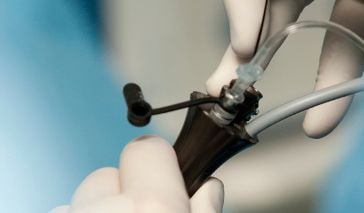Laparoscopy is a surgical approach that uses a small, lighted video camera (laparoscope) to allow surgeons to visualize internal organs and other structures in the abdomen and groin so as to diagnose and treat disease or injury. Unlike open surgery, which requires large incisions, laparoscopy requires only small cuts that result in reduced postoperative pain and faster recovery.
What is Laparoscopy Used For?
Laparoscopic surgery can be employed for a variety of diagnostics and surgeries, including:
- Identifying internal injury after an accident
- Locating and removing abnormal growths, such as tumors or cysts
- Draining cysts
- Removing a small piece of tissue for testing (biopsy)
- Determine whether cancer has spread
In urology, laparoscopic surgery can be used for numerous procedures, including kidney surgery, bladder repair, prostate removal, removing large kidney or ureter stones, ureteropelvic junction obstruction, varicocele repair, undescended testes, adrenal cancer, and more.
How is Laparoscopy Done?
Depending on the specific surgery, laparoscopic procedures can be performed in an outpatient surgical center or a hospital, under general anesthesia or using only local anesthetic to numb the incision area. The surgeon will first make a small cut in the abdomen and insert a hollow needle, which is used to inject gas (either carbon dioxide or nitrous oxide) and slowly inflate the belly. This lifts the abdominal wall and allows the surgeon to more clearly visualize a patient's internal organs. The laparoscope is then inserted through the same incision. To diagnose or assess a condition, a laparoscope is typically all that's required. For more extensive surgical procedures, such as biopsies, organ removal, cyst drainage, etc., additional tools can be inserted through other incisions.
After the procedure, the surgeon removes all tools, releases the gas, and closes the incision.
Recovery after a Laparoscopy
Patients can usually resume most normal activities the day after their laparoscopic procedures, but should avoid strenuous exercise or activity for at least a week.
Over the first few days, patients may feel tired and have pain and bruising around the incision. Those who had general anesthesia, which requires a tube inserted in their throat, may have a tender or sore throat. All of this should clear up on its own. And because gas is used to inflate the abdomen, patients may experience bloating or the increased urge to urinate.
Additionally, a little gas can sometimes leak into the skin and cause a crackling sound around the incision. This is not serious and should go away after a few days.
Risks of Laparoscopic Surgery
Because laparoscopy requires smaller incisions than open surgery, the procedure carries fewer risks. The main ones include: bleeding from the incisions, infection, or damage to a blood vessel or internal organ, something that can cause additional bleeding or even require open surgery.
Patients should contact their doctor if they experience any of the following:
- Increased redness or swelling around the incision
- Drainage or bleeding from the incision
- Fever
- Severe pain in the belly
- Hoarse voice that lasts for more than a few days
Collins S., Lehman D.S., McDougall E.M., et al. (2012). AUA BLUS Handbook of Laparoscopic and Robotic Fundamentals. American Urological Association.


